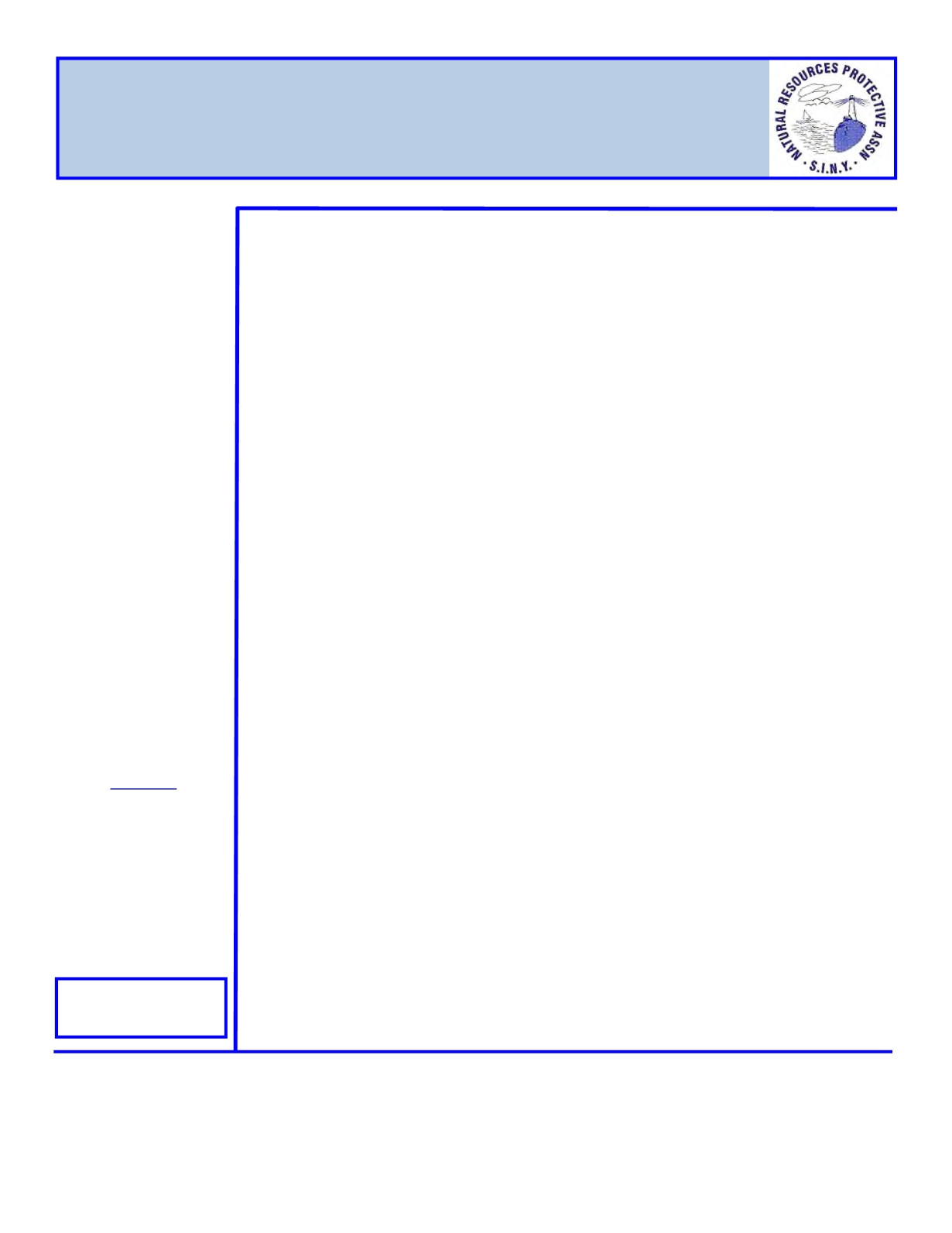
N
atural
R
esources
P
rotec ve
A
ssocia on
Coali on Against Water Disposal of Contaminated Sediments
Post Office Box 050328
Staten Island, NY 10305
718-873-4291
A Publica on of the
Summer 2016
In this Edi on
Executive Director
Ida Sanoff
CAWD
Director
Tony Rose
Staten Island Sport Divers
Director
Richard Chan
NRPA
President
Jim Scarcella
NRPA
Friends of Clearwater
Vice President
Charles Perry
Protectors of Pine Oak
Woods
Secretary
Daniel Ingellis
NRPA
Assistant Secretary
Tony Rose
Staten Island Sport Divers
Treasurer
Membership
Newsletter
Richard Chan
NRPA
Assistant Treasurer
John Malizia
S. I. Yacht Club,
S. I. Tuna Club, FCA
TRUSTEES
Dr. Martin Schreibman
Brooklyn College AREAC
Dr. John T. Tancredi
Molloy College
Andrew Willner
NY/NJ Baykeeper
(Ret)
Cindy Zipf
Clean Ocean Action
Page 1-3 A Trip to the Pumping Stations of South-
ern Brooklyn
Page 3-4 What Can One Person Do?
In Memory of Edward “Kerry” Sullivan
Page 4-5 Sharrott Avenue Fishing Pier
Cleanup
Page 5-6 DEP Presentation
Page 6 Conference House Park Cleanup
Page 7 Upcoming Events
A TRIP TO THE PUMPING STATIONS OF
SOUTHERN BROOKLYN
By Ida Sanoff
Your NRPA board members are involved in a
wide variety of shoreline projects. We attend
many civic and environmental meetings each
month. Some are about clean water, habitat
and fisheries issues and since Hurricane
Sandy, many are about flood control. Some
involve all of the above. But once in a while,
after spending untold hours as a volunteer,
you can get a very special opportunity: The
chance to see parts of the city that are not
open to the general public.
As part of a major flood control project for
Coney Island Creek, I was part of a group
that toured two different pumping stations.
The objective was to learn what role, if any,
these stations played in water quality and to
brainstorm about their impacts in the upcom-
ing flood control project.
We all know what a sewage treatment plant
looks like. These very large, industrial struc-
tures are located behind forbidding chain link
fences and they are hard to miss. But what
most people don’t know is that in addition to
these large facilities, there are over ninety
sewage pumping stations located throughout
the city. In most areas of the city, sewage
and storm water flow to the treatment plants
by gravity. But in low lying areas, gravity
alone is insufficient to get sewage to the
treatment plants. As its name implies, a
pumping station is a building with some huge
capacity pumps. Sewage and storm water is
then pumped through massive pipes called
force mains to the main plant for treatment.
Many pumping stations look like just another
warehouse or nondescript industrial building.
But right near 86
th
Street in Brooklyn, there is
a lovely, tile roofed, Beaux Arts building
which houses the Avenue V Pumping Station.
It was constructed in 1917, when the City be-
lieved that even buildings with the most hum-
ble purpose should have an imposing appear-
ance. Back then, sewage treatment consist-
ed of just pumping raw sewage to the nearest
waterway, which in this case, was Coney Is-
land Creek.
Although still in use, the Avenue V Pumping
Station had fallen into disrepair. Its large,
arched windows had been covered with
boards because they were pocked with bullet
holes. Pigeons flew freely inside the building.
But the worst part was that the capacity of the
pumping station was woefully inadequate for
modern times. Since there are combined
sewer lines in the area, millions of gallons of
storm water are added to the system with eve-
ry rain. As a result, the Avenue V Pumping
Station diverted over 300 million gallons a
year of this combination of untreated sewage
and storm water (called CSO – Combined
Sewer Overflow) directly into Coney Island
Creek.
A few years ago, the pumping station was
upgraded under a NYS Consent Order that
mandated improved water quality and by all
standards, this project was a home run! The
project cost over $200 million and it looks like
the money was well spent. The capacity of
the Avenue V Pumping Station was more than
doubled. It used to be able to pump 30 million
gallons of wastewater a day to the Owl’s Head
Water Treatment Plant and now it can pump
80 million gallons a day. That means that the
amount of sewage diverted into the receiving
body of water – Coney Island Creek – has
been reduced by almost 90%. While that is a
remarkable achievement, there is even more
reason for celebration: This interesting build-
ing has been lovingly restored to its former
glory.
As our group gathered outside the station, we
had a chance to admire the 15 foot tall arched
windows, decorative cornices and the large
golden eagle atop the flagpole.
We started our tour in the rear yard, where
there are several large trap doors in the ce-
ment. These are the covers to the wet wells,
where sewage first enters the facility. There
Join NRPA today
See page 6


